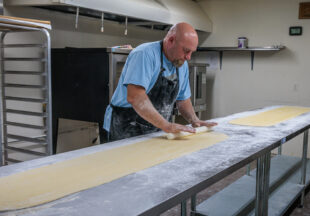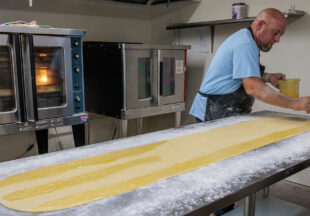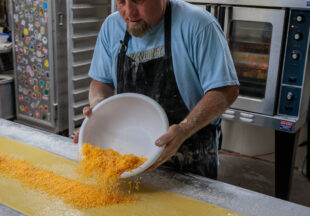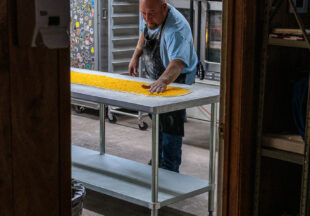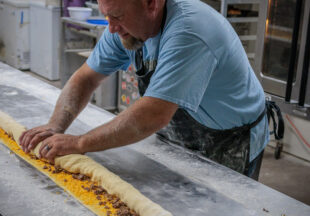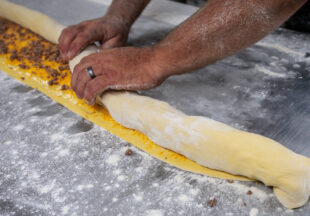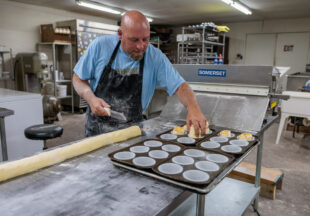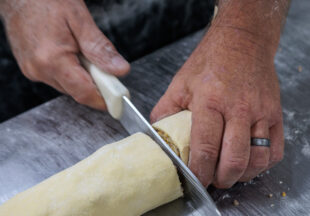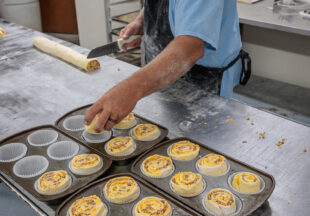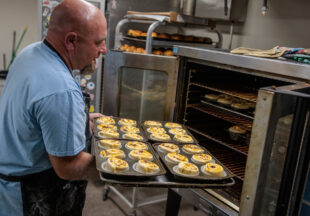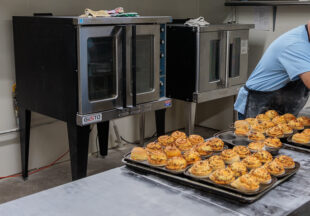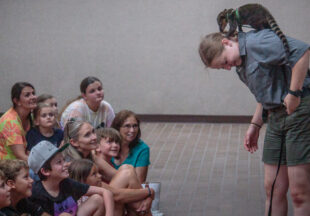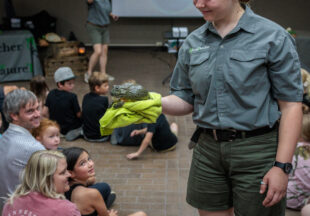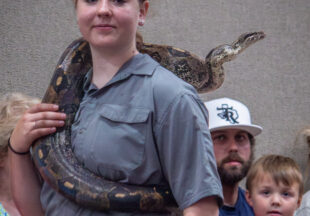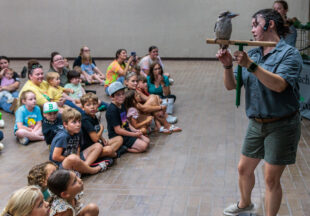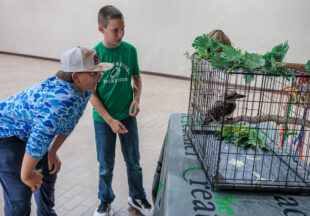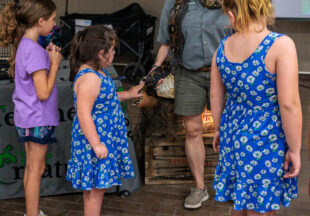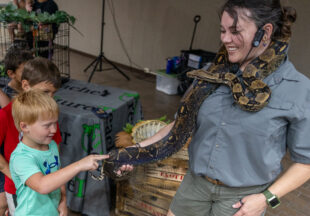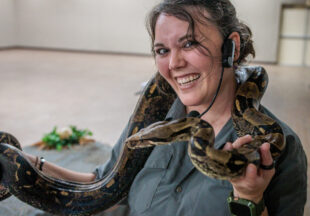Emergency burn ban extended as high heat, drought continue
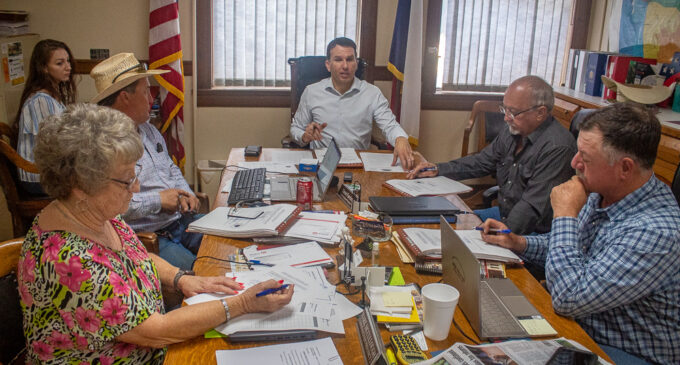
By Carla McKeown/Breckenridge Texan
The Stephens County Commissioners met in an emergency meeting this morning, July 18, to extend the Disaster Declaration for 30 days, banning outdoor burning due to the extreme dry conditions in the county.
According to Texas A&M University’s Texas Weather Connection website, Stephens County has an average Keetch-Byram Drought Index (KBDI) of 660 today, with the maximum being 715 in the southwestern/southcentral and the northeast portions of the county, and the minimum being 568, mostly in the northwest and northcentral portion. Most of the county is in the middle, in the 600-700 range. The Texas A&M Forest Service explains that in the 400-600 KBDI range, wildfire intensity begins to increase significantly. Above 600, wildfires will show extreme intensity.

Stephens County Fire Marshal Wayne McMullen talks to the County Commissioners at their emergency meeting on Monday, July 18, about the extreme heat and fire dangers. (Photo by Tony Pilkington/Breckenridge Texan)
At this morning’s meeting, County Judge Michael Roach said that the current Declaration of Disaster will be reconsidered at the end of 30 days or if the KBDI is reduced due to significant rain.
The order prohibits all outdoor burning, including open fire pits (such as campfires for cooking), brush clearing, etc. The order does allow for outdoor cooking in enclosed barbecue pits/grills “that are built to contain the flames safely.”
Additionally, some outdoor work-related activities, such as welding and/or grinding are allowed under specific circumstances. The disaster declaration states that anyone conducting such work follow stringent rules as follows: “in addition to the individual(s) performing the work, a spotter to supervise any activity to prevent a fire or its spreading. A minimum of 50 gallons of water and an adequate dispensing mechanism (pump and hose) must be in the immediate vicinity of the activity where a flame or spark(s) are emitted.”
The work-related exception only applies to activities that might emit a flame or spark, not to actual burning. Brush burning, trash burning, etc. are banned for the duration of the Declaration of Disaster.
“So, I think we’ve struck a balance here that understands people have to work but also that public safety is important,” Roach said. “And it’s gonna get a lot worse. If you’ve seen the forecast for this week, I think, was it Tuesday or Wednesday is going to be a really bad day. Any day over 100 is a bad day, but yeah, Tuesday, tomorrow, 112 is what is forecast. So it’s only going to get worse as the as the week goes on and for however long this lasts. Some people are saying, you know, into August and maybe further than that. It’s going to be bad for a while.”
This afternoon, a large fire is burning at Possum Kingdom Lake in the area of FM 1148 and Hawkins Road. According to unofficial reports, one or more structures have been involved in the fire and several volunteer fire departments in the area are fighting the blaze.
Click here to see the full declaration.
Heat Danger
In addition to the dangers of wildfire, the extreme heat can cause a variety of health problems.
The American Red Cross offers these tips for dealing with a heat wave:
Stay Connected
- Never leave infants, children, older adults, individuals with disabilities or pets in a vehicle unattended. Cars can quickly heat up to dangerous temperatures, even with a window cracked open.
- Check-in on older adults and individuals with chronic health conditions at least twice daily. When visiting, ask yourself these questions:
- Are they drinking enough water?
- Do they have access to air conditioning?
- Do they know how to keep cool?
- Do they show any signs of heat stress?
- Be on the lookout for signs of heat-related illness. Act right away if you notice someone with symptoms.
- If someone is showing signs of heat exhaustion or heat stroke seek emergency medical care immediately.
Stay Hydrated
- Drink plenty of fluids: Don’t wait until you’re thirsty to drink. Avoid sugary, caffeinated or alcoholic drinks. Avoid icy beverages because they can cause stomach cramps.
- Replace salt and minerals: Heavy sweating removes salt and minerals from your body that need to be replaced. A sports drink or a snack can replace the salt and minerals you lose in sweat.
- Keep pets hydrated: Provide plenty of fresh water for your pets and leave the water in a shady area.
- Warning: If your doctor limits the amount of water you drink or has you on water pills, ask how much you should drink while the weather is hot. If you are on a low-salt diet, have diabetes, high blood pressure, or other chronic conditions, talk with your doctor before drinking a sports beverage.
Stay Cool
- Stay cool indoors: Stay in an air-conditioned place as much as possible.
- Wear appropriate clothing: Choose lightweight, light-colored, and loose-fitting clothing.
- Don’t use an electric fan when the indoor air temperature is over 95 degrees F. Using a fan can be more harmful than helpful when indoor air temperatures are hotter than your body temperature. Fan use may cause your body to gain heat instead of losing it. Focus on staying hydrated, taking a cool shower or bath to cool your body, shutting out the sun and heat with curtains, and moving to an airconditioned place to cool off.
- Use your stove and oven less.
- Schedule outdoor work and other activities carefully: Try to limit your outdoor activity to when it’s coolest, such as morning and evening hours. Rest often in shady areas so that your body has a chance to recover.
- Cut down on exercise during the heat.
- When outdoors, protect yourself from the sun by wearing a wide-brimmed hat, sunglasses, and sunscreen that says “broad spectrum” or “UVA/UVB protection.”
Check for children
According to the website No Heat Stroke, at least 10 children have died in hot cars in the United States this year, including two in Texas. Last year, 23 children died from heat stroke after being left in vehicles.
Jan Null, CCM, Department of Meteorology and Climate Science at San Jose State University tracks U.S. child vehicular heatstroke deaths. Additionally, the website includes research into exactly how hot it gets inside a car in the heat. According to the research, at only 80 degrees, the temperature inside a vehicle can reach 100 degrees in a little over 10 minutes.
At the outside temperatures the Breckenridge area has been experiencing lately, the researchers have only estimates, based on their numbers from lower temperatures. However, they estimate that at 105 degrees outside, the interior of a vehicle will reach almost 150 degrees in a hour. Within 2-4 hours on a day with a temperature of 110, the interior of the vehicle can reach 160 degrees or hotter.
Noheatstroke.org offers the following safety tips:
- Never leave a child unattended in a vehicle. Not even for a minute!
- If you see a child unattended in a hot vehicle call 9-1-1.
- Be sure that all occupants leave the vehicle when unloading. Don’t overlook sleeping babies.
- Always lock your car and ensure children do not have access to keys or remote entry devices. Teach children that vehicles are never to be used as a play area.
- If a child is missing, always check the pool first, and then the car, including the trunk.
- Keep a stuffed animal in the car seat and when the child is put in the seat place the animal in the front with the driver. Or place your purse, briefcase or cell phone in the back seat as a reminder that you have your child in the car.
- Make “look before you leave” a routine whenever you get out of the car.
- Have a plan that your childcare provider will call you if your child does not show up for school.
Forecast
The National Weather Service’s data from the Stephens County Airport shows that the temperature reached 110 a little after 3:30 p.m. today. The official NWS forecast for Tuesday, July 19, is for 110, but other weather sites are predicting 111 or 112.
Every forecast available shows temperatures of more than 100 degrees every day thought the end of the July.
Stephens County and more than two dozen other counties in North and Northcentral Texas are under an Excessive Heat Warning through Tuesday night and a Hazardous Weather Outlook for the next week due to the heat.
Cutline, top photo: The Stephens County Commissioners held an emergency meeting Monday morning, July 18, to consider the Declaration of Disaster that they issued last week due to the extreme heat and drought conditions. With the high temperatures and low rain chances continuing, they voted to extend the order another 30 days. (Photo by Tony Pilkington/Breckenridge Texan)
Make sure you don’t miss any of the Breckenridge Texan’s news…click here to sign up for our email newsletter, the Weekly News Roundup. It has links to stories, photo galleries and more! It’s free to sign up, and it comes to you on Monday mornings (sometimes on Tuesdays after a holiday).










